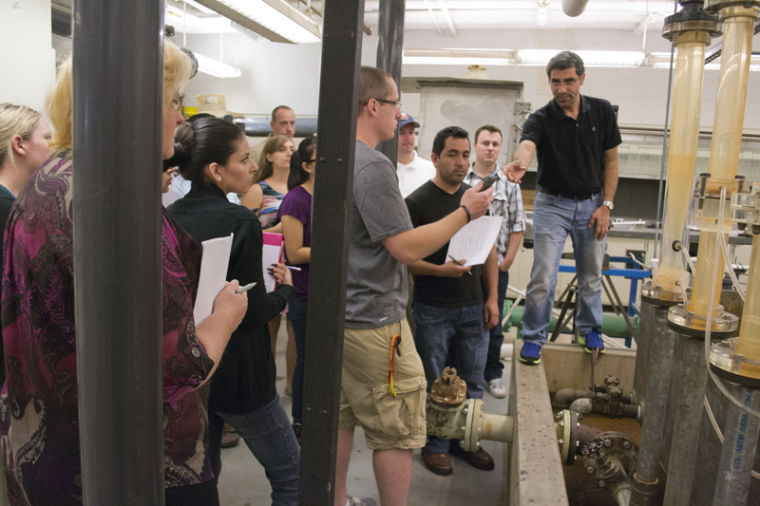Civil engineering students benefit from faculty teaching methods
Dr. Saad Merrayan talks to his students in one of the labs in the civil engineering department. The department has taken many steps to ensure that that its students excel in their fields.
September 25, 2013
The civil engineering program at Sacramento State has built a reputation by forming leaders in recent years and continues to uphold it.
Faculty in the program has helped form well-versed students by constantly encouraging them to get involved in student organizations to gain more experience and learn outside the classroom.
“Professors try to get us out there,” said Katherine Aguilar, 21, civil engineering major. “They do more than just academics. They try to get you involved in student organizations.”
She said professors not only do an exceptional job in teaching, but they also do a great job in ensuring students are gaining experience in order to become better prepared students.
The program has kept a good reputation throughout the years with receiving recognitions in academics and projects outside the classroom that have been supported by faculty.
One of the latest accomplishments includes Sac State’s Concrete Canoe and Steel Bridge teams qualifying for Nationals at the American Society of Civil Engineers Mid-Pacific Conference this year.
This was the first time in the program’s 50 year history both teams were invited in the same year. The canoe team placed eighth in the nation.
The civil engineering program has not only brought success in competitions but in the classroom by having faculty with the best experience in the field.
Graduating senior, Kenneth Lee Wright, 39 said since arriving at Sac State, his civil engineering professors have been nothing but the best.
“Most have extensive real world working knowledge in the field, and those that don’t, tend to have engaged in cutting edge research and are known in the field for their knowledge,” Wright said.
With programs like Excellence in Civil Engineering Education, and only 12 full-time faculty, the program manages to work closely with students through interactive teaching methods fully preparing students for careers.
“This program offers both a breadth and depth of courses in civil engineering, and our students are prepared for professional practice as civil engineers when they graduate,” said Kevan Shafizadeh, civil engineering department chair.
Excellence in Civil Engineering Education, or ExCEEd, targets new civil engineering faculty and introduces them to the fundamentals of teaching. It addresses learning objectives, teaching with technology, communication skills and classroom assessment techniques.
Civil engineering professor Saad Merayyan attended the seminar and said there is so much to learn about how to keep students interacted and interested in the subject matter.
“You think you know how to teach and have the skills for teaching, but they open up your eyes to so many things you haven’t thought of or actually considered,” Merayyan said.
Matthew Salveson, professor and graduate coordinator for the department of civil engineering, has helped in the seminar by sharing effective teaching techniques across the country in the ExCEEd program. He once attended the workshop, but now serves as a mentor.
Salveson also leads workshops for part-time faculty during the summer and teaches them some of the methods.
He said his students have complex ways in learning, and tailors as much as he can within each lecture to fit their style of learning. Some of his methods include using photographs, sketches and physical models in his classes allowing students to interact.
“There are students who tend to understand things through a more global standpoint,” Salveson said. “They want to see the bigger picture then get into the smaller details. Then there are other people who want to understand all the little details first, then move on into the big picture.”
Two of the methods faculty on taught in the ExCEEd seminar are to always have objectives and to use a lot of color.
Professors use color when teaching on the board. Each segment of the board has a color to accentuate major headings and points of emphasis. It’s a systematic approach to use five colors in order for students to match colors with what they are learning.
“There’s a hierarchal system in how I apply colors so it emphasizes to students,” said Eugene Dammel, professor in the department of civil engineering. “ If I circle something with green chalk, that emphasizes to students that will be on the test.”
The civil engineering program also focuses on project based learning. Since engineering is about designing, faculty ensures students participate in hands-on learning.
Wright said he believes he will be well prepared to go forward into the professional field because of the project based courses.
“In our last semester before obtaining a bachelor’s degree, civil engineering majors have a capstone course,” Wright said. “In it, civil engineering majors are broken into teams, given a real world type project and have to work toward completing it just like we would in the real world in an engineering firm.”
The civil engineering program currently has 776 undergraduate and 102 graduate students with 120 graduating students this semester.
Although, there is not a precise number on employment rates of former students, Merrayan said many of the program’s graduates are wanted for employment. Many are hired by government agencies, privates sectors, the California Department of Transportation and the California Department of Water and Resources.
Dammel said he believes civil engineering continues to be one of the best programs in the west because the faculty knows how to teach students to become successful in academics and in the professional field.
“The department and university has been very fortunate to have the quality of faculty we have here,” Dammel said. “We have been able to attract excellent faculty and I hope we can keep them.”





























































































































